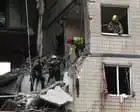Ukraine war briefing: Russia deliberately ‘endangering nuclear safety in Europe’ says Kyiv

Ukraine says drones are targeting substations that power the Khmelnytskyi and Rivne nuclear plants. What we know on day 1,355
See all of our Russia-Ukraine war coverage
Russia is again targeting substations that power the Khmelnytskyi and Rivne nuclear power plants in Ukraine, the country’s foreign minister Andrii Sybiha said on X on Saturday. Sybiha said drone attacks on the weekend were not accidental but well-planned strikes. “Russia is deliberately endangering nuclear safety in Europe,” he said.
Russia launched a barrage of drones and missiles at Ukraine over the weekend, killing at least seven people and damaging energy infrastructure in three regions , according to Ukrainian officials. Ukraine’s president, Volodymyr Zelenskyy, said Russia had launched more than 450 drones and 45 missiles, most of which were shot down. Three people were killed and 12 wounded when a drone hit an apartment building in Dnipro, and another person was killed in the Kharkiv region. Three were killed in the south-eastern Zaporizhzhia region, regional officials said.
Russian foreign minister Sergei Lavrov said on Saturday work was under way on President Vladimir Putin’s order to prepare proposals for a possible Russian nuclear test , state news agency TASS reported. The order was in response to President Donald Trump’s surprise announcement last month that the US would resume testing. Russia-US relations have deteriorated sharply in the past few weeks because of Trump’s frustration about the lack of progress towards ending the war in Ukraine.
A second external power line to the Russian-held Zaporizhzhia nuclear power plant in Ukraine has been restored , the station’s Russian operators were quoted as saying on Saturday. The plant – Europe’s largest, with six reactors – was seized by Russian troops in the first weeks of the February 2022 invasion of Ukraine. It currently produces no electricity, but needs external power to cool the nuclear fuel and avoid the risk of a meltdown.
Millions of tonnes of Russian oil have been traded through a port in Singapore part-owned by Australia’s Macquarie Bank and potentially sold to Australian businesses, new data shows. The identification of a new link between Australia and the trade in Russian-origin products exposes further gaps in government sanctions, as Australia lags Europe and UK in tightening import rules. Australia stopped buying fuel directly from Russia after its invasion of Ukraine but has imported more than 3m tonnes of Russian-originating oil products since 2023, the Europe-based Centre for Research on Energy and Clean Air (Crea) has found.
Hungary said on Saturday it had obtained an indefinite waiver from US sanctions to use Russian oil and gas , but a White House official reaffirmed the exemption was for one year only. Last month, US President Donald Trump imposed Ukraine-related sanctions on Russian oil companies Lukoil and Rosneft that carried a threat of further sanctions against entities that buy oil from those firms. Hungary, which relies heavily on Russian energy, asked for a reprieve from the sanctions.
Old fishing nets from France are becoming a vital protection against Russian drones attacking Ukraine . In fishing ports along the coast of Brittany, discarded horsehair fishing nets, previously a waste problem, are being used to catch Russian drones. Russia employs small cheap drones and fits them with explosives, directing them by remote control for distances of up to 25km. The Ukrainians use the nets to create tunnels in which drone propellers become entangled.
Continue reading...









